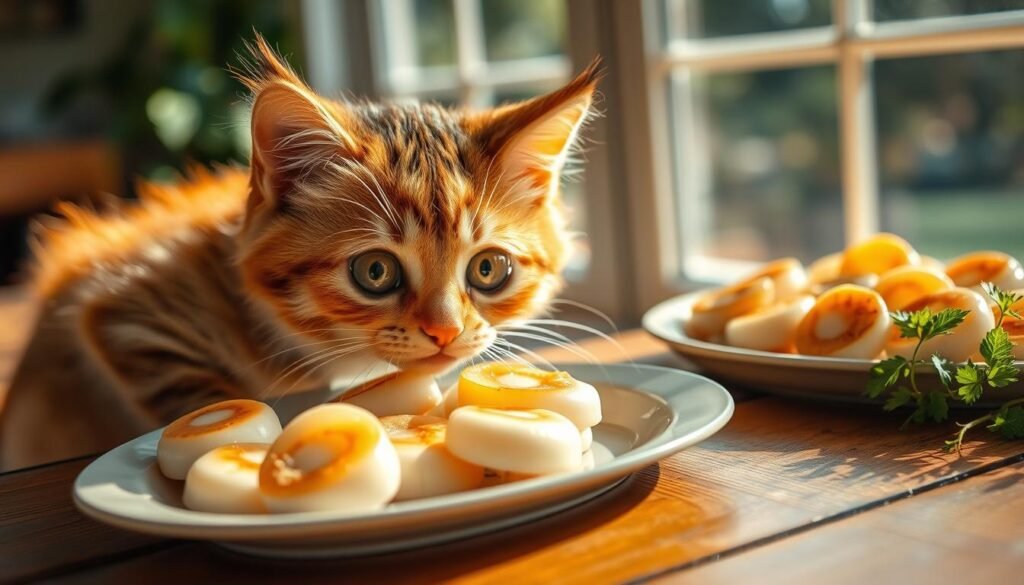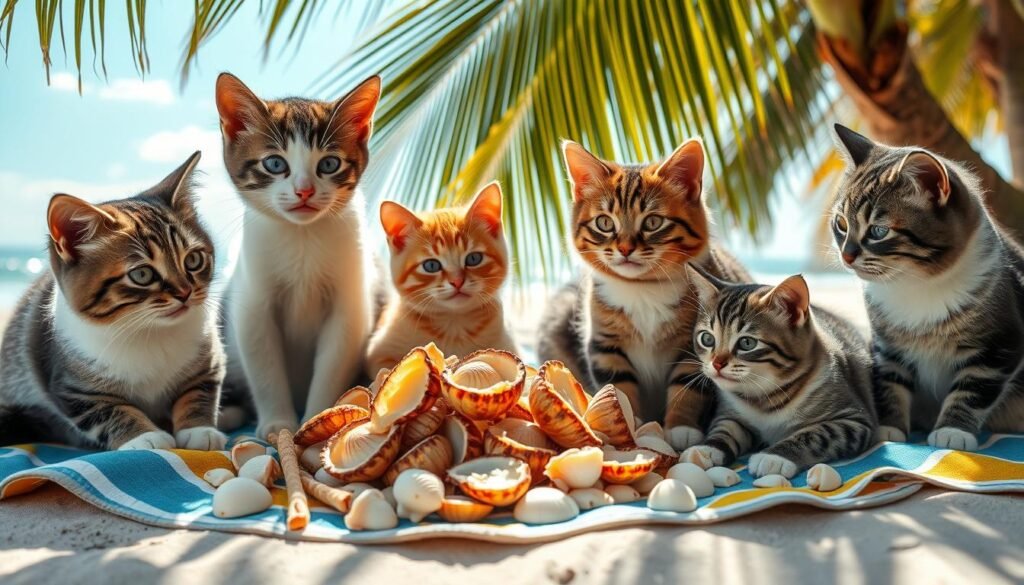As a cat owner, you might wonder if cats can eat scallops. Cats and scallops can be a good mix, but knowing the safety and benefits is key. Yes, cats can eat scallops, but with some care. Scallops add healthy nutrients and protein to your cat’s diet.

Before adding scallops to your cat’s diet, think about the risks and benefits. Seafood can add variety and nutrition, but safely is crucial. This article will dive into seafood for cats, focusing on scallops and how to safely add them to your cat’s meals.
Key Takeaways
- Can cats eat scallops as part of their diet seafood?
- Cats and scallops can be a healthy combination with proper preparation.
- Scallops provide essential nutrients and protein for your feline friend.
- It’s crucial to consider the potential risks and benefits of feeding scallops to your cat.
- Cats diet seafood should be introduced safely and in moderation.
- Consult with your veterinarian before making any changes to your cat’s diet.
- Proper preparation and cooking methods are essential for safe consumption.
The Safety of Feeding Scallops to Cats
Feeding scallops to cats can be safe and healthy if done right. Scallops are a good choice for safe seafood for cats. But, it’s important to think about the risks of raw versus cooked scallops. Raw scallops can be risky, while cooked ones are safer.
When giving scallops to your cat, remember a few things:
- Only give cooked scallops, as raw ones might have Salmonella
- Make sure to remove any shells or bones to avoid choking hazards
- Scallops are high in protein, so give them in small amounts
Feeding your cat shellfish for cats can be healthy. But, it’s key to cook and handle it right to avoid health risks. With the right precautions, your cat can enjoy safe for cats seafood like scallops.
For specific guidelines, cook scallops well before giving them to your cat. Only give them in small amounts as an occasional treat. This way, you can keep your cat safe and healthy.
Raw vs Cooked Scallops
Cooked scallops are safer for cats than raw ones. They are less likely to have Salmonella. Still, it’s important to cook and handle scallops correctly to avoid health risks.
Potential Health Risks
Feeding scallops to your cat can have health risks. Raw or undercooked scallops can cause food poisoning. Cats might also be allergic to scallops. So, watch your cat’s behavior and health after trying scallops for the first time.
Safety Guidelines for Cat Owners
To keep your cat safe with scallops, follow proper cooking and handling. Cook scallops well, remove shells or bones, and give them in moderation. These steps help ensure your cat enjoys scallops safely and healthily.
| Seafood | Safety for Cats |
|---|---|
| Scallops | Safe, as long as cooked properly |
| Shrimp | Safe, as long as cooked properly |
| Salmon | Safe, as long as cooked properly |
Nutritional Benefits of Scallops for Felines
Scallops can be a great addition to your cat’s diet. They offer essential protein, omega-3 fatty acids, and other important nutrients. It’s key to know how these nutrients help your cat stay healthy.
Scallops are rich in protein. This is vital for building and fixing muscles, organs, and tissues in cats.
Some of the main benefits of scallops for cats are:
- High-quality protein for muscle growth and maintenance
- Omega-3 fatty acids for healthy skin, coat, and joints
- Rich in vitamins and minerals like vitamin B12 and selenium
When thinking about can cats have scallops, consider the good and bad. Scallops can be good for your cat’s diet, but only in small amounts. A balanced diet with scallops for cats ensures they get all the nutrients they need.
Adding scallops for cats to their diet can improve their health. It can make their skin and coat better and help their joints. Always watch how your cat reacts to new foods. By knowing the benefits of scallops for cats and adding them carefully, you can give your cat a healthy diet.
How to Properly Prepare Scallops for Your Cat
Feeding scallops to cats needs careful preparation to keep them safe and happy. Scallops can be a tasty and healthy treat for pets. But, it’s important to prepare them right to avoid health risks.
First, figure out the right amount of scallops for your cat. Start with 1-2 teaspoons per 10 pounds of body weight. This helps avoid stomach problems. You can then increase the amount based on your cat’s needs and how well they can handle it.
Recommended Serving Sizes and Cooking Methods
When cooking scallops for your cat, avoid high heat like frying or grilling. These methods can create harmful substances. Instead, use gentle methods like steaming or poaching. Here are some safe tips:
- Wash your hands well before and after handling scallops
- Rinse the scallops under cold water to remove any dirt
- Pat the scallops dry with a paper towel to avoid too much moisture
- Cook the scallops until they are opaque and firm to the touch
By following these steps and being careful, you can share scallops with your cat safely. Always put your cat’s health first. If you’re unsure about adding scallops to their diet, talk to your vet.
| Scallop Preparation Method | Safety Level |
|---|---|
| Steaming | High |
| Poaching | High |
| Grilling | Low |
| Frying | Low |
Signs Your Cat May Be Allergic to Scallops
Scallops can be good for your cat’s diet, but some cats might be allergic to shellfish. If you think your cat is allergic to scallops, you should talk to your vet. Cats can show allergies in many ways, like skin problems, stomach issues, or breathing troubles.
Some common signs of food allergies in cats include:
- Skin irritation and itching
- Digestive issues, such as diarrhea or vomiting
- Respiratory problems, such as coughing or sneezing
If your cat shows these symptoms after eating scallops or other seafood, get vet advice fast. Your vet can figure out if your cat has a food allergy. They might suggest other protein sources, like cats eat seafood like salmon or cod.
Remember, every cat is unique, and what’s good for one might not be for another. If you want to add scallops to your cat’s diet, do it slowly and in small amounts. Watch for any bad reactions. Knowing the signs of a food allergy and taking steps to avoid them can help keep your cat healthy and happy.
Can Cats Eat Scallops as Part of Their Regular Diet?
Seafood can be a great addition to a cat’s diet, offering essential nutrients and protein. Scallops and cats can have a good relationship if prepared and served right. It’s important to know how often and how to prepare seafood for cats.
To add scallops to your cat’s diet, think about the benefits and risks. A balanced and varied diet is key. Scallops can be a good choice, but it’s important to follow some guidelines.
Frequency Recommendations
It’s best to limit seafood to 1-2 times a week for cats. This keeps their diet varied and prevents mercury poisoning. Make sure scallops are cooked well and without shells or bones.
Alternative Seafood Options
Other seafood options for cats include salmon, cod, and shrimp. They offer similar benefits to scallops. Choose fresh, sustainable seafood and avoid high-mercury or toxic options.
In conclusion, cats can enjoy scallops in their diet if prepared correctly. Follow the recommended frequency and consider other seafood options. This way, you can give your cat a healthy, balanced diet with seafood.
| Seafood Option | Nutritional Benefits | Frequency Recommendation |
|---|---|---|
| Scallops | High in protein, low in fat | 1-2 times a week |
| Salmom | Rich in omega-3 fatty acids | 1-2 times a week |
| Cod | Good source of protein and vitamins | 1-2 times a week |
Understanding Your Cat’s Seafood Preferences
When it comes to cats and scallops, or any seafood for cats, understanding their individual preferences is crucial. Every cat is different, and what works for one may not work for another. Cats eat seafood, but introducing new foods, including seafood for cats, requires careful consideration.
Research on cat behavior and preferences shows that cats have unique tastes and dislikes. Some cats may love cats and scallops, while others may prefer other types of seafood for cats. To understand your cat’s seafood preferences, observe their behavior and reactions to different types of seafood.
Here are some tips to help you understand your cat’s seafood preferences:
- Start with small amounts: Introduce new seafood for cats in small amounts to gauge their reaction.
- Watch for signs: Observe your cat’s behavior, such as eating eagerly or showing disinterest.
- Consider allergies: Be aware of potential allergies to seafood for cats, including cats and scallops.
By understanding your cat’s seafood preferences, you can make informed decisions about what to feed them. Remember, cats eat seafood, but it’s essential to prioritize their individual needs and preferences.

| Seafood Type | Cat Preference |
|---|---|
| Scallops | Varies by cat |
| Salmon | Generally well-liked |
| Shrimp | May cause allergies in some cats |
Potential Risks of Shellfish for Cats
Feeding shellfish to cats can be risky. Shellfish are nutritious but can harm your cat’s health. It’s important to prepare and serve them safely and in small amounts.
Shellfish can pose mercury poisoning and digestive problems. While cats can eat shellfish, knowing the risks is key. Mercury poisoning can lead to vomiting, diarrhea, and stomach pain.
Mercury Concerns
Mercury is toxic and can be found in some shellfish. Cats eating mercury-contaminated shellfish risk poisoning. Symptoms include vomiting, diarrhea, and stomach pain. Choose low-mercury shellfish like scallops or shrimp to reduce risks.
Digestive Issues
Shellfish can also cause digestive problems in cats. Some cats may be allergic or sensitive, leading to vomiting, diarrhea, or other issues. If your cat shows these symptoms, see a vet to adjust their diet.
In summary, shellfish can be good for cats but with risks. Choose low-mercury options and watch your cat’s health. Prioritize your cat’s safety and health when considering shellfish.
| Shellfish | Mercry Level | Safety for Cats |
|---|---|---|
| Scallops | Low | Safe for cats |
| Shrimp | Low | Safe for cats |
| Lobster | High | Not safe for cats |
Best Practices for Introducing Scallops to Your Cat’s Diet
Thinking about can cats have scallops in their diet? It’s key to introduce them slowly and safely. Scallops can be a tasty, cat-friendly seafood choice. But, it’s important to avoid any bad reactions.
Begin by giving your cat small amounts of cooked scallops as treats. This helps them get used to the new food without upsetting their stomach. Keep an eye on how your cat reacts, watching for signs of allergy or intolerance like vomiting or diarrhea.

Important things to remember when adding scallops to your cat’s diet include:
- Start with small amounts (about 1-2 teaspoons) and gradually increase the serving size
- Choose cooked scallops to reduce the risk of foodborne illness
- Monitor your cat’s response to the new food and adjust as needed
By following these tips and being careful, you can make sure your cat enjoys feeding scallops to cats safely and healthily.
| Food | Serving Size | Frequency |
|---|---|---|
| Scallops | 1-2 teaspoons | 2-3 times per week |
What Veterinarians Say About Cats and Scallops
Veterinarians help cat owners choose the best food for their pets. They say scallops for cats are okay as an occasional treat. Scallops are high in protein and low in fat, which is good for cats.
But, it’s important to add feline diet scallops slowly and in small amounts. This helps avoid any stomach problems.
Research shows veterinarians give these tips for adding scallops for cats to their diet:
- Start with small amounts to monitor your cat’s tolerance and potential allergic reactions
- Choose cooked scallops over raw ones to minimize the risk of foodborne illnesses
- Avoid seasoning or adding oils to the scallops, as these can be toxic to cats
Vets also stress the need for a balanced diet for cats. Cats and scallops can be a good addition. But, always talk to your vet to find the right diet for your cat.
As a responsible cat owner, it’s essential to prioritize your cat’s health and well-being by making informed decisions about their diet, including the introduction of scallops for cats.
Conclusion: Making the Right Choice for Your Feline Friend
Adding scallops to your cat’s diet can be good, but it’s important to be careful. Knowing the risks and following safety tips is key. This way, you can choose what’s best for your cat’s health.
If you want to give your cat scallops or try other seafood, talk to your vet first. They can help based on your cat’s health and what they need to eat. Always put your cat’s health and happiness first.
FAQ
Can cats eat scallops?
Yes, cats can eat scallops in moderation. They are a good source of protein and omega-3 fatty acids. But, make sure to introduce them slowly and safely.
Are scallops safe for cats to eat?
Cooked scallops are safe for cats. But, raw scallops can have harmful bacteria. Always cook them well and avoid adding salt or spices.
What are the nutritional benefits of scallops for cats?
Scallops are full of high-quality protein. They also have omega-3 fatty acids for a healthy coat and skin. Plus, they have vitamins and minerals.
How should I prepare scallops for my cat?
Cook scallops without seasonings or oils. Bake, broil, or sauté them until done. Remove tough parts and cut into small pieces.
How much scallop can I feed my cat?
Feed 1-2 small, cooked scallops per meal. This depends on your cat’s size and needs. Too much can cause digestive problems.
Are there any risks associated with feeding scallops to cats?
Scallops are safe but can cause issues in cats with seafood allergies. Raw scallops may have harmful bacteria.
How can I introduce scallops to my cat’s diet?
Start with a small amount of cooked scallop. Watch for any digestive problems. If okay, you can increase the amount slowly.
What do veterinarians say about cats and scallops?
Vets say scallops are safe and nutritious for cats, in moderation. Always check with your vet before changing your cat’s diet.

